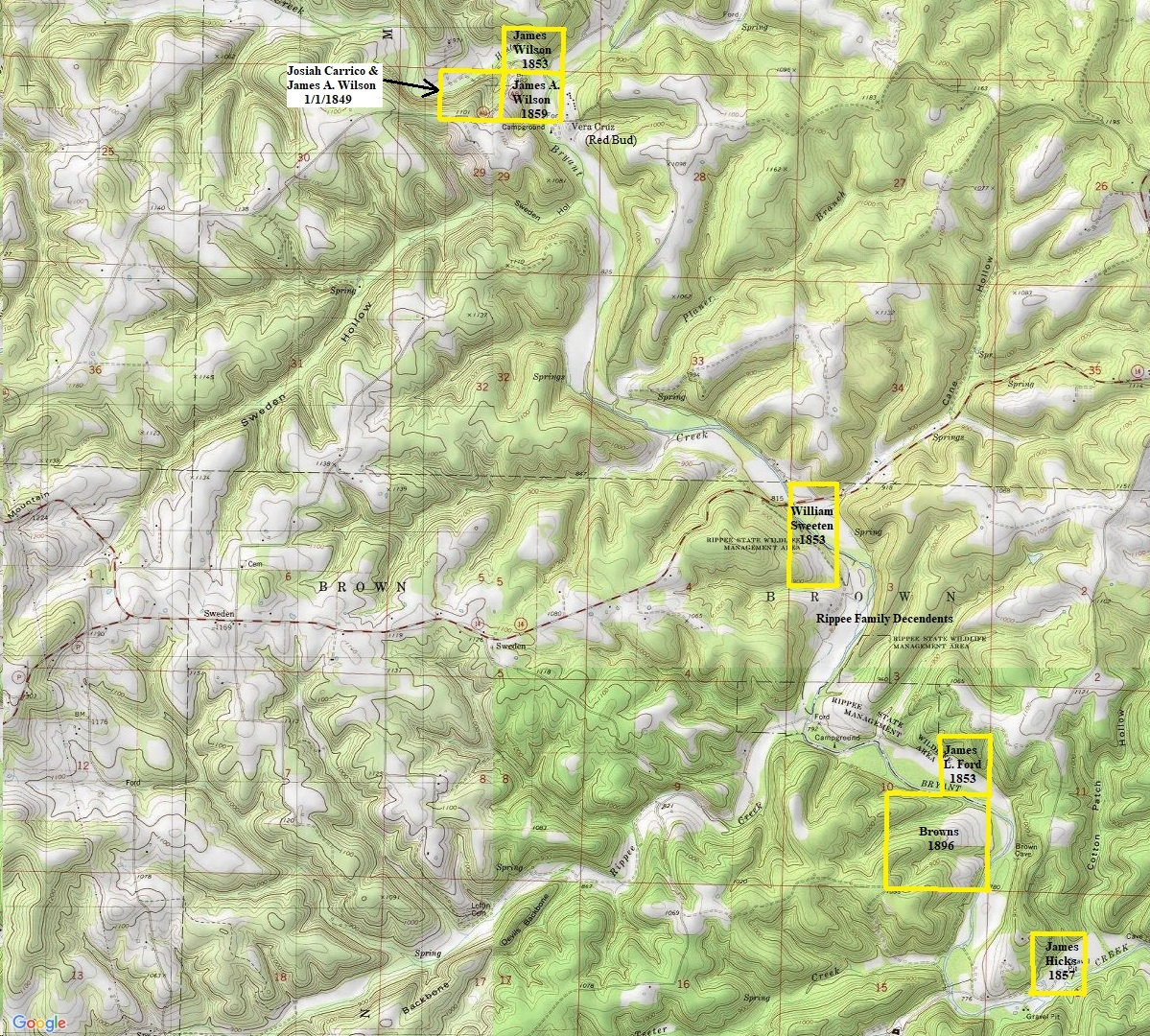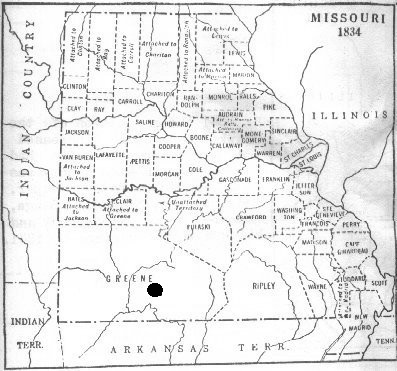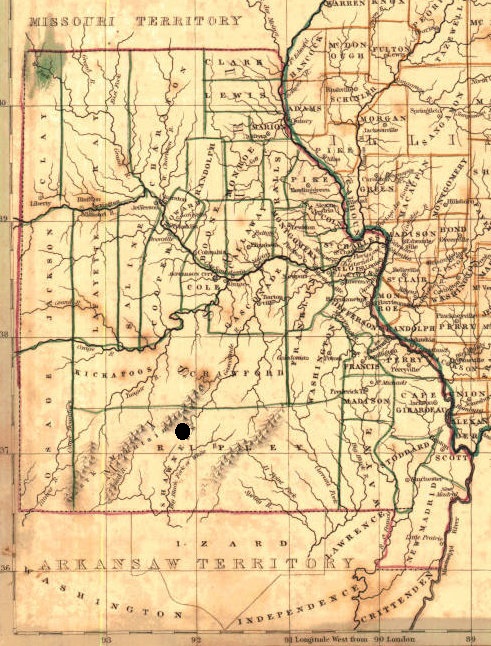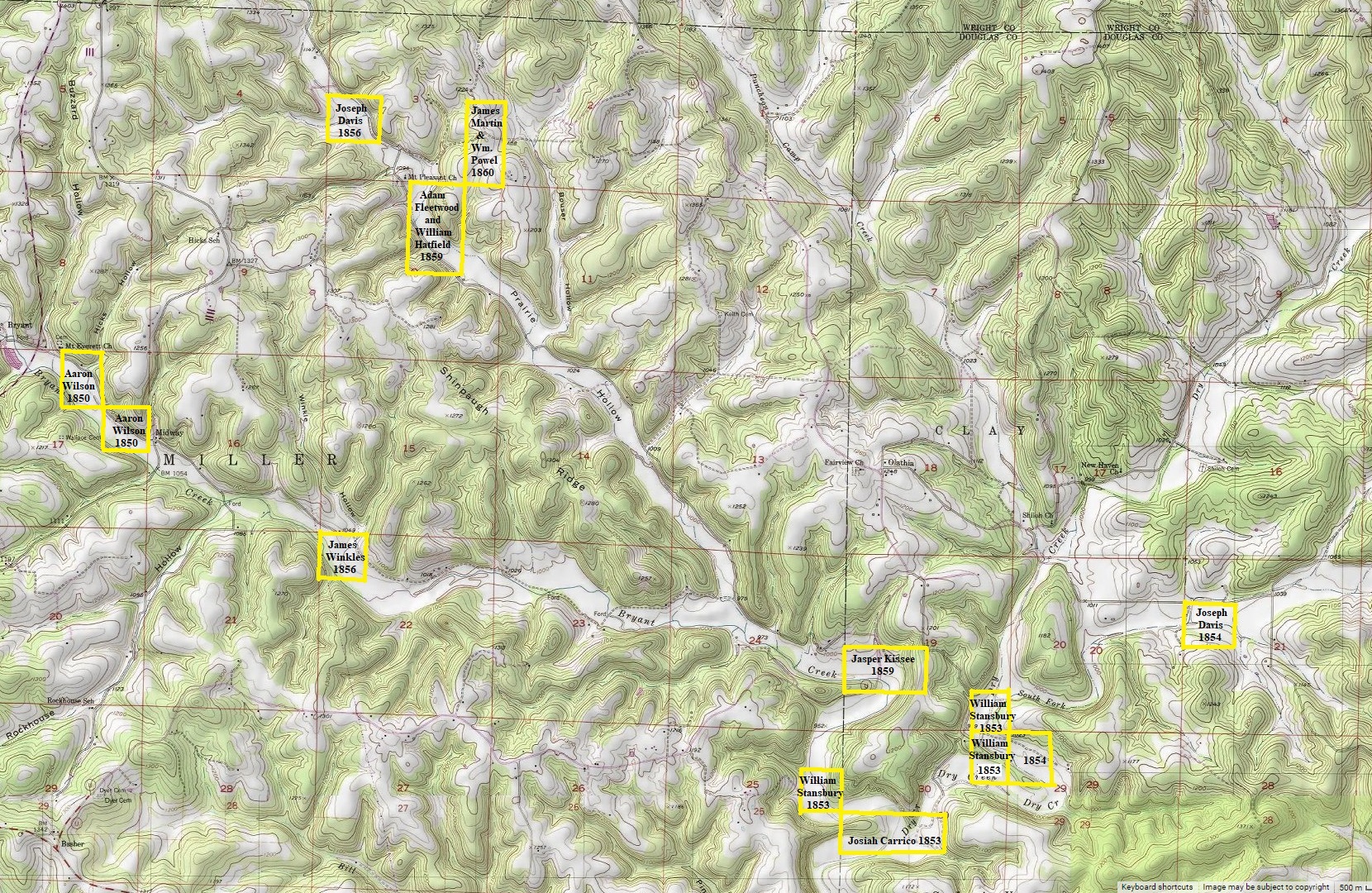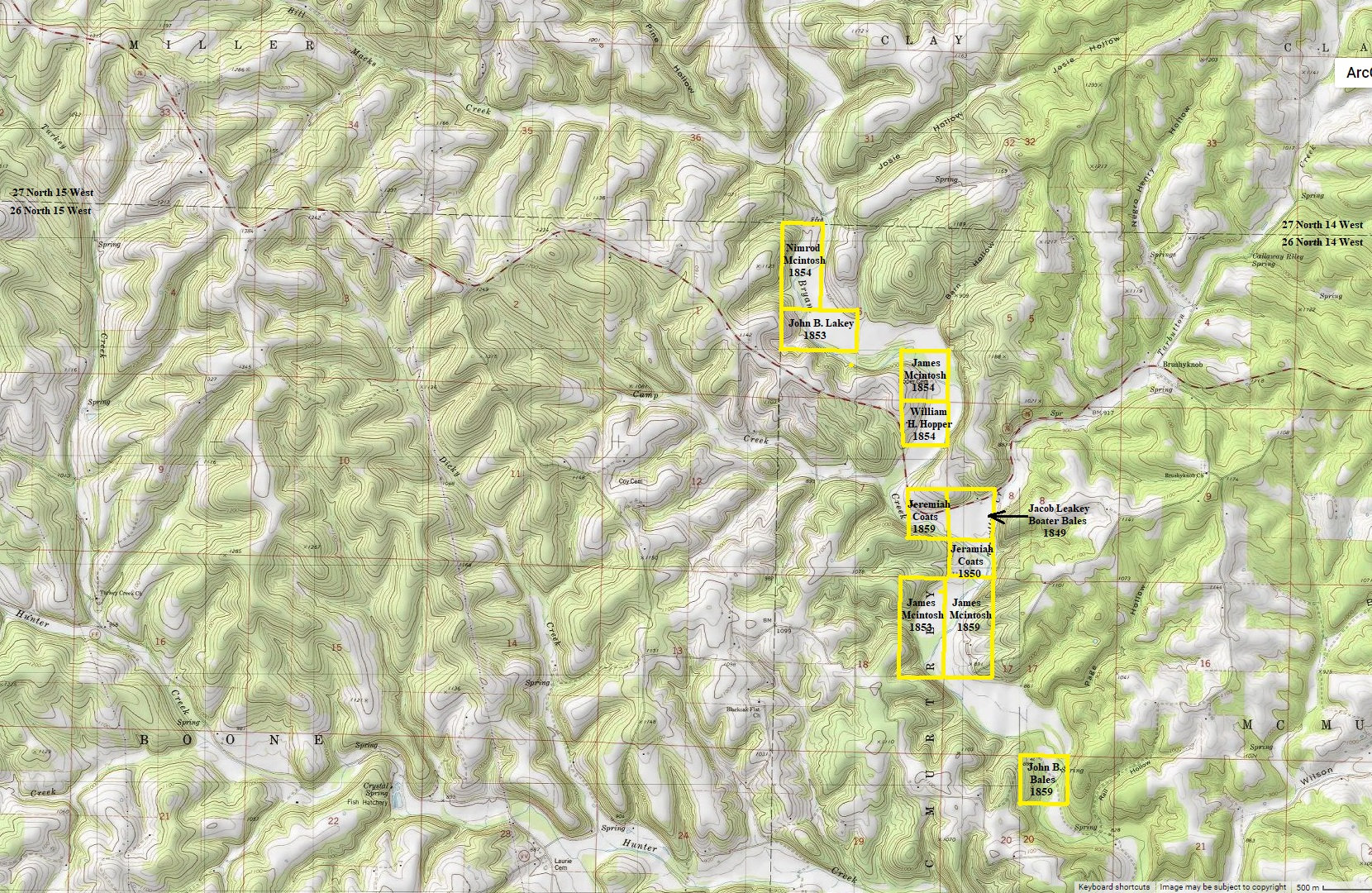Willhite Homestead at Bryant Creek Missouri 1834-1858
WillhiteWeb.com
Bryant Creek is in south central Missouri, on the edge of the Ozark Mountains, in what is known today as Douglas County. Julius and Elizabeth were pioneers in an area that was settled by the first homesteader just a few years before. In 1832, the Shawnee Tribe of Native Americans were moved from this area of Missouri and resettled to the area in northeast Kansas. This vacation of land left the area open for white settlers. The area was very primitive, no land surveys had been completed, no roads built, no services of a local government. The area was part of Greene County Missouri, with the county seat of Springfield a distant 75 miles away. Over the next 23 years, new counties would be made putting the settlers in 4 different counties (Greene to Taney to Ozark to Douglas) yet they never actually moved. Of the homesteaders in the area, a large percentage were from southern Indiana, who migrated there from Kentucky. This particular flood of migration from Kentucky to Indiana to Missouri lasted around 20 years. In the early years on Bryant Creek, it was mostly hunting, trading items at trading posts and clearing a few acres of land for food.
Elizabeth and Julius had their first child in 1835, Joseph Wilhite (possibly named for his good friend Joseph Hatfield). The next son born was Smith (again, a name used by Joseph Hatfield for his first son). Three more boys followed, all being born along Bryant Creek. Although little known about Julius and Elizabeth other than what exists about them on the 1840 and 1850 census records, there is plenty of stories from their neighbors along Bryant Creek. The setting is simple, they are in a narrow-forested valley surrounded by rolling hills with the large Bryant Creek passing through. One trail that follows the edge of Bryant Creek takes people up and down the valley. Each new family that came down the trail would probably talk with homesteaders and pass along information. The Wilhites would ask about relatives back in Kentucky and Indiana, while the travelers would be seeking guidance as to what lay beyond the bend and conditions in the Ozarks.
By the 1840s, they enjoyed watching a civilized community (although primitive) form in the Bryant Creek Valley. In 1840, a census taker came to the Willhite home and recorded that they had two children under the age of 5. This was Joseph Wilhite born 1835 and Smith Wilhite born in 1838. In that 1840 census, his good friend Joseph Hatfield was next door.
In 1841, the Bryant Creek area was reassigned from Taney County into a smaller county called Ozark with the county seat placed at Rockbridge just a few miles away along the creek from the Wilhite home. New conveniences suddenly became available. For example, in 1842, a post office was established at Rockbridge; now letters could be sent and received by the valley settlers. Also in 1842, the trail that went by the Wilhite cabin became known as the Rockbridge-Hartville Road. This increased the traffic on the road as the main route between the two communities. In 1843, the State Survey Office in St. Louis contracted professional survey chain crews to come through southern Missouri laying out the land in one-mile square grids by which subsequent land title could be recorded. Surveyors were welcomed because the settlers understood they were laying out the framework by which they could apply for and obtain legal title to the land each family had staked out for itself. They came through Bryant Creek in the fall and winter months of 1846. They made notes of the local residents they found living on the land. Although Julius Wilhite is not on their sketches, many of their neighbors names were on the maps.
In 1853, Julius and Elizabeth's oldest son Joseph turned 18 and moved north marrying Elizabeth Tyler. They married in Pettis County, had a few children. Joseph’s wife’s father died young and Joseph helped his widowed mother-in-law raise a large family. Both of these families moved to Garnett, Kansas Territory around 1855, thereby becoming the first Wilhite in Kansas.
Back at Bryant Creek, around this same time in the mid 1850's, Robert Hicks (a neighbor of Julius Wilhite) had applied for and established a post office he called Red Bud, later know as Vera Cruz. Another neighbor Jeremiah Coats became the second postmaster. Today the tiny town of Vera Cruz is a historic sight and public recreation area. A big change occurred in 1857 when Douglas County was split off from Ozark county. The local community of Vera Cruz was named the county seat. So, Douglas County is today the location of the homestead, Vera Cruz and Bryant Creek.
Sometime in 1858, Julius and Elizabeth Wilhite left for Kansas Territory with their four remaining children, Smith, John, Lewis and Henry. It's unknown why they left but it is good they did. Where they were living on the county’s main Rockbridge to Hartville Road along Bryant Creek would have put the family in harm’s way as the Civil War started to play out in 1861. Confederate forces came up that road on at least two occasions while on their way to Hartville and Springfield. As they came through with cavalry, cannon and foot soldiers, they destroyed the Union fortifications that had been placed at Vera Cruz with a volley of munitions from the hillsides above.
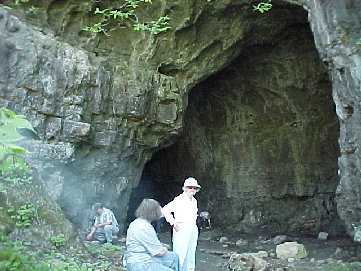

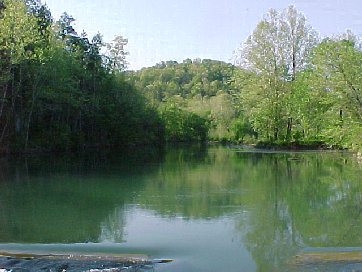
Websites to other homesteaders on Bryant Creek and other useful websites
1840 Census Homesteaders near Bryant Creek
Please contact me if you have anything to add.
Last update: Jan 2023
Bryant Creek
Bryant Creek
Browns Cave
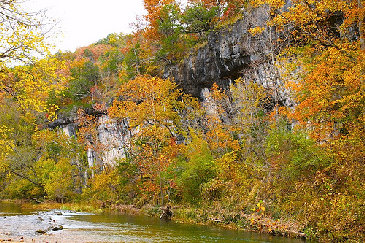
Bryant Creek, Vera Cruz access
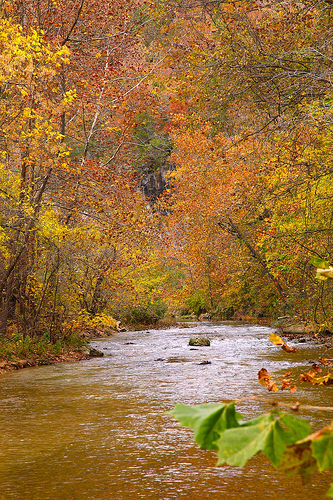
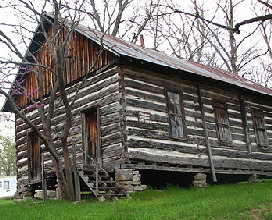
Historic cabin in Vera Cruz
Photos from The Ozark Uncle
Bryant Creek, Vera Cruz access
Missouri 1834 County Map
Missouri 1835
Here are two maps in the mid 1830s. Bryant Creek is near the big black dots. If you want to see more maps, click the link on the right.
Archibald Evans
George W Hetherly
Squire Hunter
Washington Jackson
Thomas Mercer
John Williams
Benjamin Cooper
Patrick Riley Jr.
Solomon Collins
Absalom Cooper
John Hinchey
Jacham Cradock
James Riley
Jackson Cramb
William Riley
Joseph F Gifford
James Petter
Davis Fields
William Sweeton
Jeramiah Coats
John Jr. Burden
Isaac Stark
Athol Stark
Eleazer Poplin
John Turnbull
Abraham Childers
Nelly Turnbull
David Childers
Isaac Collins
Isaiah Collins
James Conoway
James James
Samuel Davis
Harey Teeter
Davied Cutbirth
Patrick Riley
Isaac Cooper
Solomon Collins
John Jones
Henry Pearson
George Riley
Adam Fleetwood
John Burden
John G Carter
Polly Couch
Drury Davies
Drury Upshaw
John S Upshaw
Robert A Martin
Andrew Coats
John Cootze
William M Thornly
William Williams
Joseph Thornley
Richard Thornley
John Young
Thomas Simons
Almer Jorden
James Campbell
Asa Nelson
William Murril
Alferd Coffey
James Gideons
Clement Womack
Levi Boswell
Henry Bartlett
Solomon Willis
L D Patton
John Holt
Harman Collins
Aron Callins Sr.
Aron Collins Jr.
Johnson Baris
Richard Hankins
Stephen Holt
Francis Holt
William Veres
Julius Wilhite
Thomas Kissee
Joseph Hatfield
John Wilkins
T Hopper
Bowter Bales
James Anders
William Shelton
Hiram Davis
Isaac Fleetwood
James Winkles
Elihu Brown (Lyhue)
Elijah Hutson
Landowners on the 1840 and 1850 census.
Map Below
On the 1850 census, Julius Wilhite was recorded right between the families of Joseph Davis and Josiah Carrico. It seems reasonable to then believe that the land Julius was settled on was somewhere between their property, on Dry Creek or the South Fork of Dry Creek.
Likely on the tributary Dry Creek or the South Fork of Dry Creek. I am getting closer to the exact plot.
